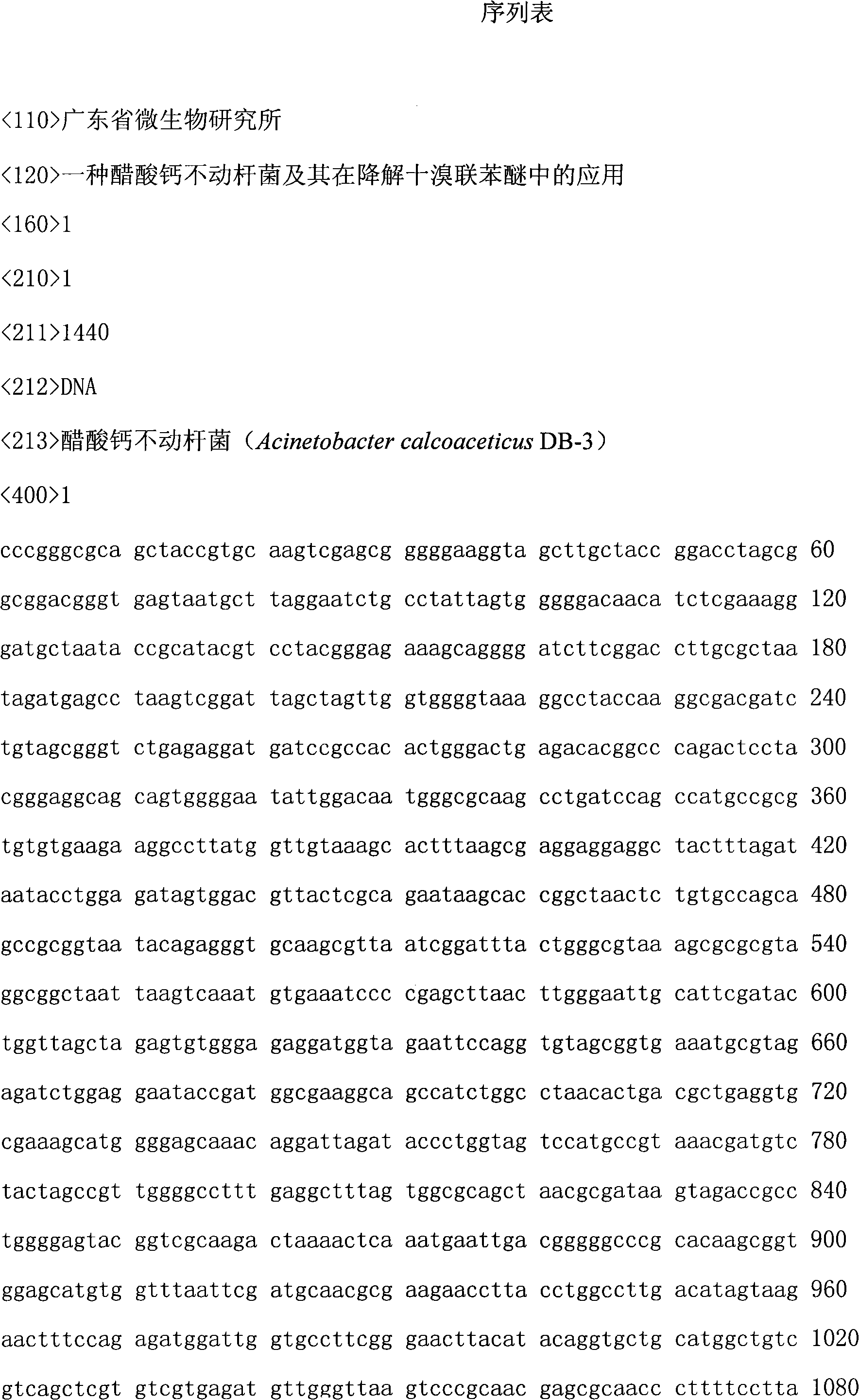Acinetobacter calcoaceticus and application thereof in degrading decabromodiphenyl ether
A technology of decabromodiphenyl ether and calcium acetate, applied in the direction of bacteria, microorganism-based methods, microorganisms, etc., can solve the problems of degrading decabromodiphenyl ether that have not been reported, and achieve no secondary pollution, low cost, high efficiency effect
- Summary
- Abstract
- Description
- Claims
- Application Information
AI Technical Summary
Problems solved by technology
Method used
Image
Examples
Embodiment 1
[0039] Debromination degradation test of Acinetobacter calcoaceticus DB-3 on decabromodiphenyl ether with a concentration of 10mg / L:
[0040] Degradation basal medium formula: Each liter of medium contains 1g of peptone, 0.5g of yeast extract, KH 2 PO 4 2.93g, Na 2 HPO 4 8.87g, NH 4 Cl 1.0g, NaCl 0.5g, MgSO 4 5g, CaCl 2 2H 2 O 0.15g, the balance is water.
[0041] 1. Prepare a degradation experiment medium containing 10 mg / L of decabromodiphenyl ether:
[0042] Add 1ml of 300mg / L decabromodiphenyl ether stock solution dissolved in dichloromethane to a 100ml conical flask, avoid light until the dichloromethane volatilizes, then add 30ml of degradation basal medium to the conical flask, shake well to obtain 30ml of degradative Experiment medium.
[0043] That is, the formula of the degradation experiment medium: each liter of medium contains 10 mg of decabromodiphenyl ether, 1 g of peptone, 0.5 g of yeast extract, and KH 2 PO 4 2.93g, Na 2 HPO 4 8.87g, NH 4 Cl 1.0g...
Embodiment 2
[0053] Debromination degradation test of Acinetobacter calcoaceticus DB-3 on decabromodiphenyl ether with a concentration of 10mg / L:
[0054] 1. Prepare a degradation experiment medium containing 10 mg / L of decabromodiphenyl ether:
[0055] The degradation test medium in this embodiment is the same as the degradation test medium in Example 1.
[0056] 2. Cultivate the Acinetobacter calcoaceticus DB-3 pure bacteria of the present invention on LB plate, then pick a single colony from the solid LB plate and inoculate it into 30ml of degradation experiment medium, cultivate it at 30°C and 150 rpm in the dark, and cultivate it for 60h Finally, take the culture solution, utilize ion chromatography to analyze the bromide ion concentration in the culture solution, and do three parallel samples in the experiment.
[0057] 3. Determination of the degradation rate of Acinetobacter calcoaceticus DB-3:
[0058] Take 2mL of the above-mentioned culture solution from three parallel samples,...
Embodiment 3
[0060] Debromination degradation test of Acinetobacter calcoaceticus DB-3 on decabromodiphenyl ether with a concentration of 10mg / L:
[0061] 1. Prepare a degradation experiment medium containing 10 mg / L of decabromodiphenyl ether:
[0062] The degradation test medium in this embodiment is the same as the degradation test medium in Example 1.
[0063] 2. Routinely culture the Acinetobacter calcoaceticus DB-3 pure bacteria of the present invention on an LB plate, then pick a single bacterium from the solid LB plate and inoculate it into a 30ml degradation experiment medium, and culture it at 30°C and 150 rpm in the dark for 72 hours , take the culture solution, use ion chromatography to analyze the bromide ion concentration in the culture solution, and do three parallel samples in the experiment.
[0064] 3. Determination of the degradation rate of Acinetobacter calcoaceticus DB-3:
[0065] Take 2mL of the above-mentioned culture solution from three parallel samples, filter i...
PUM
 Login to View More
Login to View More Abstract
Description
Claims
Application Information
 Login to View More
Login to View More - R&D
- Intellectual Property
- Life Sciences
- Materials
- Tech Scout
- Unparalleled Data Quality
- Higher Quality Content
- 60% Fewer Hallucinations
Browse by: Latest US Patents, China's latest patents, Technical Efficacy Thesaurus, Application Domain, Technology Topic, Popular Technical Reports.
© 2025 PatSnap. All rights reserved.Legal|Privacy policy|Modern Slavery Act Transparency Statement|Sitemap|About US| Contact US: help@patsnap.com


